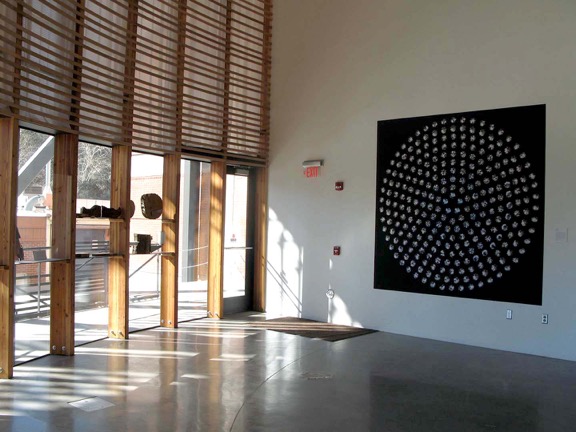Art in the Tree-Ring Lab
The exhibit, “Marking Time to a Changing Planet”, is now on display in the Bannister Building, and has featured in several news articles. You may view the pieces in the ground-level lobby at any time the building is open (8 AM to 5 PM, Monday through Friday), and in other areas on the regularly scheduled tours, or by appointment.
The Art
Kejun Li
Plastic/Wood
Archival digital art prints
18 in. × 18 in. 2014
The combination of a life-long practice in Chinese brush painting and the summer course in Dendrochronology here at the Tree-Ring Laboratory has resulted in the series Plastic|Wood. The work was made by dragging oil-based printmaking ink across a sheet of glass with an expired credit card. Kejun Li is a graduate student in Visual Communications in the UA School of Art.
“Each tree ring contains a large quantity of information and so does a credit card. I’m interested in making connections between these two different kinds of information, the natural and the artificial. I was pleasantly surprised to discover that with a single sweep tree rings could be imitated so accurately including early wood, fire scars, false rings, fungus and so on.”
Ellen McMahon
Change Over Time
275 Archival digital art prints and paint
96in, × 96 in. 2015
Change over Time is the result of a collaboration between professors Ellen McMahon, School of Art and David Breshears, School of Natural Resources and the Environment. The goal was to raise awareness of recent accelerated forest die-off due to drought, insect damage and warming temperatures in the Southwestern US. McMahon has reconfigured the hemispheric images used by Breshears and his team in their forest mortality research into concentric rings with healthy stands of Ponderosa Pine in the center gradually giving way to dead Piñon Pine/Juniper forests in the outer rings. Telling the story of change through time, like the tree section it faces in the building’s lobby, it also suggests the stained glass windows of the 12th Century. This work is motivated by an interest in how scientific data, when reinterpreted through the lens of art, can offer an experience beyond the didactic and towards a more universal sense of wonder and discovery.
Hemispheric photographs by Patrick D. Royer. Special thanks to Peter Althoff of the OSCR Multimedia Zone, David Huber of the School of Art Digital Print Lab, Cook and Company Signmakers, and Tucson Die.
Thomas Saffle
In the Storm
monotype - black ink
27.5in. × 55.5in. 2014
(triptych)
Desert Rain
monotype - black ink
29.5in. × 43.5in. 2014
(diptych)
Clear of the Storm
monotype - black ink
89.5in. × 84.5in. 2014
(polytych – 12 panels)
Present Time
Oil paint on e-panel
176in. × 48in. 2015
Natural imagery including trees, vast, empty expanses of space and stormy weather act as metaphors for personal introspection in Thomas Saffle’s work. These reinterpretations of nature represent life’s universal themes symbolically and suggest their nearing, happening, and passing through time. Using only black and white in prints, drawings, and paintings Saffle communicates the darkness of tribulation and the light of understanding and peace—how tragic events can uplift us and make us better as they pass. Thomas Saffle is a graduate student in Visual Communications in the UA School of Art.
“Art has always been a refuge for my mind from the mundane and I was always the refugee. My ambition is to create artworks that persuade the viewer to suspend their disbelief and take temporary refuge from the ordinary in the landscapes I create.”
Jesse Chehak
Sequoiadendron giganteum
8 RA-4 Type Color Photographs 2009
Kodak Supra N mounted to archival board
Print Size: 20cm × 26cm each
Paper Size: 28cm × 35.5cm each
Frame Size: 28.6cm × 36.2cm
Edition 3/6 + 1 A.P.
Signed and titled en verso


